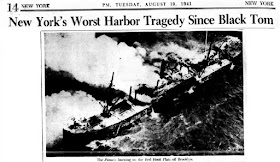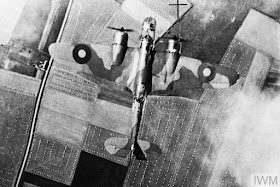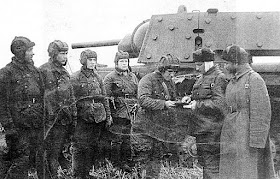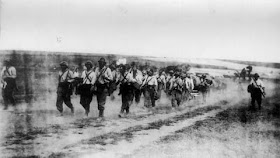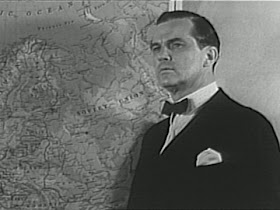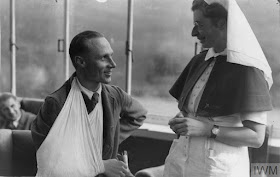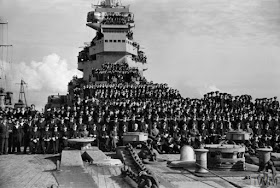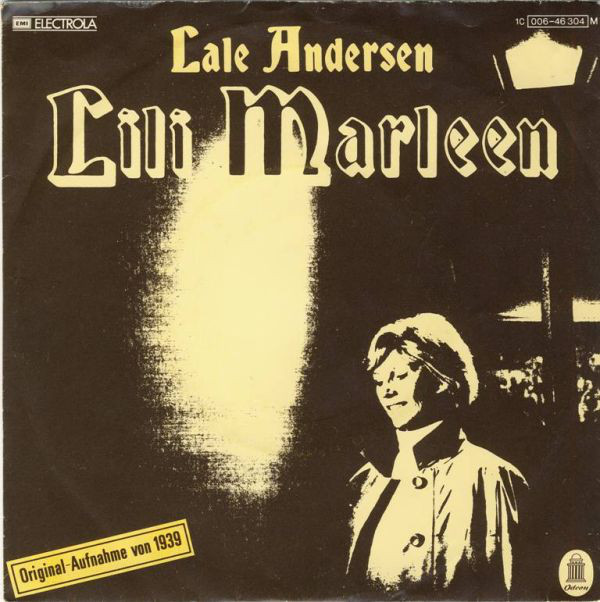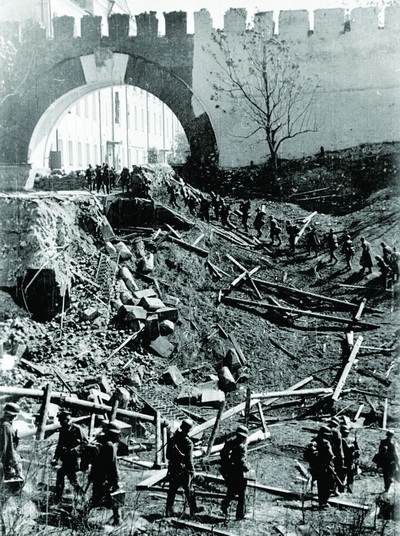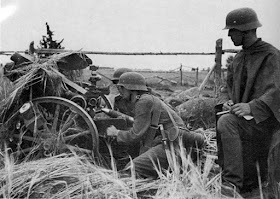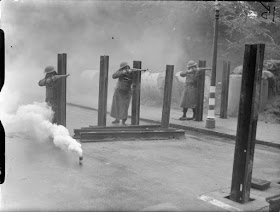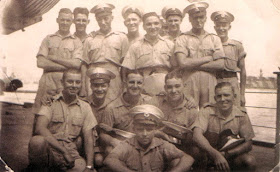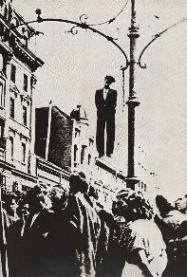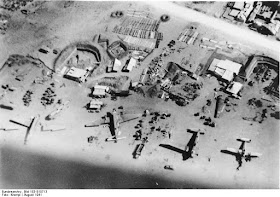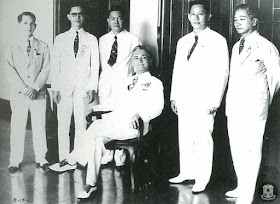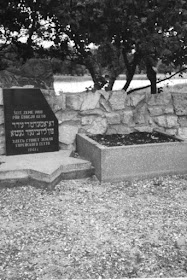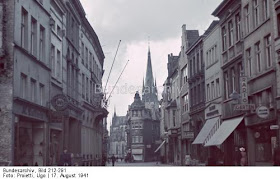Tuesday 19 August 1941
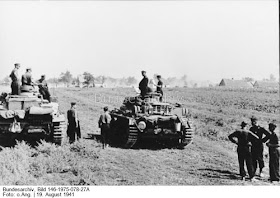 |
| German Panzer IIIs on the Eastern Front (Federal Archive, Bild 146-1975-078-27A). |
Eastern Front: German General Buhle on 19 August 1941 delivers a report on an inspection tour he has made of Army Group South. As General Halder notes in the OKH war diary, Field Marshal von Rundstedt says that "Replacements urgently needed," and those that have arrived so far have been of "indifferent quality." The artillery cannot keep up with the pace of the advance because the horses that drag it are in poor shape. About 60% of the panzer force is in combat condition, which leaves little margin for error. Divisions are in varying states of readiness, with some in good shape, but some "less good" or even "poor."
In the Far North sector, Army Group Norway finally concedes that Group F of Finnish III Corps is stuck north of Ukhta (Kalevala). After a week of probing attacks, it has gotten nowhere. The Army Group shifts some of the troops to the attack on Loukhi on the Murmansk railway, which also has gotten stuck fast, and allocates a battalion to battles further north.
The Finnish 6th Division of XXXVI Corps embarks on an offensive during the early morning hours toward the Murmansk railway. It is foggy with spells of intense rain, and the main force achieves surprise and gets off to a good start. The objectives are Nurmi Lake and Nurmi Mountain, about halfway between Kayrala and Allakurtti. The main column reaches Lehtokangas by late afternoon, but the flank formations make virtually no progress. Still, it is the first movement in the area for some time, and the Germans continue to push forward with great hopefulness. They begin bringing forward a reserve regiment to reinforce the main thrust.
In the Army Group North sector, the Soviets continue attacking the German position at Staraya Russa, but the Germans are dug in and are not being dislodged. At Novgorod, the Soviets finally are pushed out of the entire city by the end of the day after the Germans dislodge some holdouts in the eastern areas. General Hoepner's Panzer Group 4 breaks out toward the Luga Highway, which leads to Leningrad. However, a single camouflaged KV-1 tank wreaks havoc on the lead tanks and delays the advance. German 18th Army attacks Tallinn, Estonia.
In the Army Group Center sector, a German Cavalry division of the 2nd Army captures Gomel and advances through it to the east. The main problem for the Germans in this sector is poor roads. The usual Soviet attacks at Yelnya are repulsed.
In the Army Group South sector, the 11th Army crosses the Bug River with XI Corps. The Red Air Force attacks German troops in the Dneipr bend. At Dnepropetrovsk, the German attack begun by "Panzer" Meyer's small reconnaissance force holds its ground, and a Soviet counterattack with 100 tanks is beaten off, with 52 Soviet tanks destroyed. The Germans are trying to capture a bridge at Cherkasy. The Soviet Fifth Army is retreating, and the Germans fear they may escape from the trap they are trying to spring between General Guderian's Panzer Group 2 heading down from the north and General von Kleist's Panzer Group 4 driving north to meet it. Soviet Rear Admiral G.V. Zhukov (no relation to Red Army General Georgy) takes command of the Soviet defense of Odesa.
European Air Operations: During the day, the RAF sends 18 Blenheim bombers on Circus missions to Gosnay and Hazebrouck. However, the bombers sent to Gosnay turn back, so only Hazebrouck is bombed. The British lose three bombers on these missions. Another two Fortresses are sent to attack Dusseldorf, but they turn back as well.
After dark, RAF Bomber Command mounts only one major attack instead of the two or three that was the standard recently. Tonight's target is Kiel, and the RAF puts 108 bombers (54 Wellingtons, 41 Hampdens, 7 Stirlings, and 6 Halifax bombers to attack railway targets. However, the weather is poor for flying, with clouds and icing conditions, and it is raining heavily over Kiel. Only 67 bombers even claim to attack the target. The British lose 3 Wellingtons and a Hampden. Damage to Kiel is barely noticed by the Germans, with no casualties and the only damage due to anti-aircraft fire returning to earth and some incendiaries that land on a swimming facility. Some of the bombers are off course and hit the airfield at Holtenau, north of Kiel, rather than the target.
The RAF also sends minor operations to Le Havre (6 Wellingtons and 3 Whitleys) and to do minelaying in the Frisian Islands (3 Hampdens). There are no losses in these minor missions.
A USAAF P-40 Warhawk crashes at Reykjavik, Iceland, killing pilot Lt. George Meeks, when he flies into a radio mast while landing and drops into the sea. He is the first US soldier to perish in Iceland. A new airfield being built at Keflavík is named "Meeks Field" in his honor before being renamed simply Keflavik Field.
Battle of the Baltic: German torpedo boat S-58 sinks 210-ton Soviet minesweeper T-51 "Pirmunas" near the south entrance to Moon Sound. Some sources say the name of this vessel is "Merikaru."
Soviet auxiliary minesweeper No. 80 is lost on this date. No reason or location is given.
According to some sources, the Luftwaffe bombs and sinks 3767-ton Soviet hospital ship Sibir today at Reval, Estonia. Other sources state the sinking occurs on 14 August. There are over 400 deaths out of a complement of 2500 wounded. Whichever date it is, as mentioned in the entry for that date, it constitutes a war crime.
Soviet submarine M-121 is launched.
The Kriegsmarine has had multiple sightings of Convoy OG-71 which have enabled it to assemble a U-boat wolf pack in its path (these include Luftwaffe sightings and sightings by both U-106 and U-201). OG-71 is heading south to Gibraltar. Today the German preparation pays off with multiple sinkings southwest of Ireland:
As usual with convoy battles, the fighting is confused, and different U-boat captains think they have sunk ships actually sunk by another U-boat. U-559, for instance, claims to sink another ship and damage another, but there is no confirmation of this. U-201 also claims to sink another ship, with no confirmation.
Fifteen survivors of Alva are picked up by 1203-ton British freighter Clonlara which itself is sunk on 22 August, and the 15 Alva survivors all perish. Six or seven other Alva survivors are picked up by tug Empire Oak and five by destroyer Boreas, but Empire Oak also is sunk later on the 22 August, killing the Alva crew that it picked up. There are similar stories for other ships - simply getting plucked out of the water by another ship does not guarantee that you ever will see land again. Some survivors are on three or even four ships before they make port.
Royal Navy submarine Trident (Cmdr. Sladen) uses its deck gun to attack 4770-ton German freighter off the Norwegian Arctic coast. Levante escapes and makes it back to port.
Italian submarine Tazzoli (Commander Fecia di Cossato) torpedoes and sinks 7313-ton Norwegian tanker Sildra south of Freetown. Everyone survives.
British 101-ton motor barge Golden Grain hits a mine and sinks a few miles east of Foulness Island. All three aboard perish.
Three survivors of 2727-ton British freighter Cathrine, sunk by U-43 (Kptlt. Luth) on 17 June, are picked up by trawler Boras in the North Atlantic convoy route. The other 24 men on board are never found.
Royal Navy destroyer Avon Vale intercepts Portuguese trawler Maria Leonor off Cape Juby and takes off survivors of British tanker Horn Shell, sunk on 26 July.
Convoy OG-72 departs from Liverpool.
Canadian corvette HMCS Sorel (Lt. John W. Dowling) is commissioned.
U-87 (Oberleutnant zur See Joachim Berger) is commissioned, U-509 is launched.
The Luftwaffe (Junkers Ju 87 Stukas) bombs and sinks Royal Navy whaler HMT Thorbryn off Tobruk. There are eight deaths, while 18 crew are taken as prisoners. Thorbryn is towing two lighters, one of which sinks (LCT-12, killing the skipper) and the other of which drifts ashore in an area of German control (skipper is taken as a prisoner). Overall, taking the three ships as a whole, 9 out of 29 men perish.
Royal Navy submarine Tetrarch (Lt Cdr Greenway) attacks an Italian freighter (the Cadamosto) just outside of Benghazi harbor but misses.
Royal Navy submarine Unbeaten (Lt Woodward) unsuccessfully attacks an Italian convoy about 15 miles north of Pantelleria.
Operation Guillotine, the British reinforcement of Cyprus, continues. Australian sloop HMAS Parramatta escorts transport Kevinbank to Famagusta.
Italian minelayers Aspromonte and Reggio lay minefield SN-43 in the Sicilian Strait.
An Italian convoy departs from Naples bound for Tripoli.
At Malta, RAF Hurricanes shoot down three Macchi 200 fighters after they patrol near Grand Harbour in the morning. In the evening, five Italian bombers drop incendiary bombs on Zeitun, killing 2 and wounding five without loss to themselves.
Battle of the Black Sea: The Soviet 2nd Destroyer Division attacks a German/Romanian convoy near Odesa, Ukraine. The destroyers fire over 450 shells but apparently cause little damage.
The Soviets scuttle river monitor Vidista at Kyiv to avoid capture.
Soviet submarine M-33 (Lt Surov) unsuccessfully attacks Romanian submarine Delfinul off Constanza, Romania.
Soviet submarine L-4 (Lt Cdr Polyakov) lays 20 mines off Cape Olinka, Romania.
Battle of the Pacific: German raider Komet has been operating off the Galapagos Islands recently. Today, it scores its third success in the area, sinking 9036-ton British freighter Devon about 200 miles southwest of the islands. The entire crew of Devon survives and board Komet as prisoners.
War Crimes: The Soviets have been evacuating isolated positions in Estonia via ship, and this has led to some tragedies. Today is another one, as the Luftwaffe bombs and sinks 3767-ton Soviet hospital ships Sibir in the Gulf of Finland. There are about 400 people on the ship who perish. By international law, sinking a hospital ship is a war crime, and the ships are clearly marked. On the Eastern Front, however, the Germans, in particular, have openly renounced the norms of warfare.
Partisans: The Germans execute Szmul Tyszelman and Henri Gautherot at the Vallée-aux-Loups in Châtenay-Malabry, Hauts-de-Seine. Tyszelman and Gautherot were among a group of about 100 demonstrators who staged a protest on 13 August 1941 at the Strasbourg – Saint-Denis metro station in Paris. The protest featured the group singing "La Marseillaise" and carrying the tricolor flag. This incident induced the German occupation authorities in France to ban the French Communist Party, and this, in turn, induces the communists to arm themselves and kill German soldiers. The entire situation escalates quickly, and by the end of August the Germans are executing numerous hostages and the resistance fighters are assassinating Germans.
US Military: The US Marine 1st Defense Battalion sets up a permanent military garrison on Wake Island with 449 recently arrived soldiers.
German Government: German Propaganda Minister Joseph Goebbels recounts in his diary a discussion that he has with the Fuhrer:
Hitler later has dinner with his cronies and justifies his orders that can send thousands of men to their deaths:
At Kiselin, Ukraine, 48 Jews are executed on the outskirts of town with the assistance of Ukrainian police.
American Homefront: Pittsburgh Pirates manager Frankie Frisch goes on the field at Brooklyn's Ebbets Field during the second game of a doubleheader (the Pirates lost the first game) because he feels it is too rainy to continue. To make his point, he carries onto the field an umbrella and opens it upright in front of the three umpires. Everyone in the stadium bursts into laughter and Head Umpire Jocko Conlan immediately ejects Frisch from the game. As he heads back to the locker room, Frisch turns and says, "Can’t a guy have any fun anymore?" Norman Rockwell uses the incident years later as an inspiration for his famous cover, "Bottom of the Sixth."
August 1941
August 1, 1941: More Executions on Crete
August 2, 1941: Uman Encirclement Closes
August 3, 1941: Bishop von Galen Denounces Euthanasia
August 4, 1941: Hitler at the Front
August 5, 1941: Soviets Surrender at Smolensk
August 6, 1941: U-Boats in the Arctic
August 7, 1941: Soviets Bomb Berlin
August 8, 1941: Uman Pocket Captured
August 9, 1941: Atlantic Conference at Placentia Bay
August 10, 1941: Soviet Bombers Mauled Over Berlin
August 11, 1941: Rita Hayworth in Life
August 12, 1941: Atlantic Charter Announced
August 13, 1941: The Soybean Car
August 14, 1941: The Anders Army Formed
August 15, 1941: Himmler at Minsk
August 16, 1941: Stalin's Order No. 270
August 17, 1941: Germans in Novgorod
August 18, 1941: Lili Marleen
August 19, 1941: Convoy OG-71 Destruction
August 20, 1941: Siege of Leningrad Begins
August 21, 1941: Stalin Enraged
August 22, 1941: Germans Take Cherkassy
August 23, 1941: Go to Kiev
August 24, 1941: Finns Surround Viipuri
August 25, 1941: Iran Invaded
August 26, 1941: The Bridge Over the Desna
August 27, 1941: Soviets Evacuate Tallinn
August 28, 1941: Evacuating Soviets Savaged
August 29, 1941: Finns take Viipuri
August 30, 1941: Operation Acid
August 31, 1941: Mannerheim Says No
2020
In the Far North sector, Army Group Norway finally concedes that Group F of Finnish III Corps is stuck north of Ukhta (Kalevala). After a week of probing attacks, it has gotten nowhere. The Army Group shifts some of the troops to the attack on Loukhi on the Murmansk railway, which also has gotten stuck fast, and allocates a battalion to battles further north.
The Finnish 6th Division of XXXVI Corps embarks on an offensive during the early morning hours toward the Murmansk railway. It is foggy with spells of intense rain, and the main force achieves surprise and gets off to a good start. The objectives are Nurmi Lake and Nurmi Mountain, about halfway between Kayrala and Allakurtti. The main column reaches Lehtokangas by late afternoon, but the flank formations make virtually no progress. Still, it is the first movement in the area for some time, and the Germans continue to push forward with great hopefulness. They begin bringing forward a reserve regiment to reinforce the main thrust.
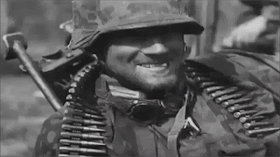 |
| A soldier of the 4th SS Polizei Panzergrenadier Division in the Leningrad Oblast area, near Luga, August-Sept 1941. |
In the Army Group Center sector, a German Cavalry division of the 2nd Army captures Gomel and advances through it to the east. The main problem for the Germans in this sector is poor roads. The usual Soviet attacks at Yelnya are repulsed.
In the Army Group South sector, the 11th Army crosses the Bug River with XI Corps. The Red Air Force attacks German troops in the Dneipr bend. At Dnepropetrovsk, the German attack begun by "Panzer" Meyer's small reconnaissance force holds its ground, and a Soviet counterattack with 100 tanks is beaten off, with 52 Soviet tanks destroyed. The Germans are trying to capture a bridge at Cherkasy. The Soviet Fifth Army is retreating, and the Germans fear they may escape from the trap they are trying to spring between General Guderian's Panzer Group 2 heading down from the north and General von Kleist's Panzer Group 4 driving north to meet it. Soviet Rear Admiral G.V. Zhukov (no relation to Red Army General Georgy) takes command of the Soviet defense of Odesa.
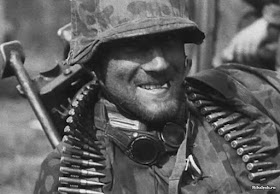 |
| Still from the above brief film of an SS man near Luga in the Army Group North sector, ca. 19 August 1941. |
After dark, RAF Bomber Command mounts only one major attack instead of the two or three that was the standard recently. Tonight's target is Kiel, and the RAF puts 108 bombers (54 Wellingtons, 41 Hampdens, 7 Stirlings, and 6 Halifax bombers to attack railway targets. However, the weather is poor for flying, with clouds and icing conditions, and it is raining heavily over Kiel. Only 67 bombers even claim to attack the target. The British lose 3 Wellingtons and a Hampden. Damage to Kiel is barely noticed by the Germans, with no casualties and the only damage due to anti-aircraft fire returning to earth and some incendiaries that land on a swimming facility. Some of the bombers are off course and hit the airfield at Holtenau, north of Kiel, rather than the target.
The RAF also sends minor operations to Le Havre (6 Wellingtons and 3 Whitleys) and to do minelaying in the Frisian Islands (3 Hampdens). There are no losses in these minor missions.
A USAAF P-40 Warhawk crashes at Reykjavik, Iceland, killing pilot Lt. George Meeks, when he flies into a radio mast while landing and drops into the sea. He is the first US soldier to perish in Iceland. A new airfield being built at Keflavík is named "Meeks Field" in his honor before being renamed simply Keflavik Field.
 |
| Sturmgeschutz III and a column of Wehrmacht soldiers on the march in Soviet territory.1941. |
Soviet auxiliary minesweeper No. 80 is lost on this date. No reason or location is given.
According to some sources, the Luftwaffe bombs and sinks 3767-ton Soviet hospital ship Sibir today at Reval, Estonia. Other sources state the sinking occurs on 14 August. There are over 400 deaths out of a complement of 2500 wounded. Whichever date it is, as mentioned in the entry for that date, it constitutes a war crime.
Soviet submarine M-121 is launched.
 |
| Allied troops landing on Spitzbergen, ca. 19 August 1941. The cargo on the dock represents the personal belongings of the inhabitants of the island who are being evacuated. |
- U-204 (Kptlt. Walter Kell) sinks 1060-ton Norwegian destroyer HNoMS Bath (43 survivors, 89 deaths, two of the 42 survivors also later pass away from wounds)
- U-201 (ObltzS Adalbert Schnee) sinks 3255-ton British liner Aguila (157 dead).
- U-201 sinks 1809-ton Ciscar (13 deaths, 35 survivors)
- U-559 (ObltzS Heidtmann) sinks 1584-ton British freighter Alva (one death).
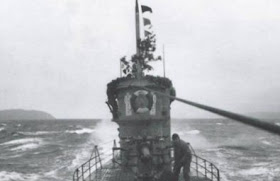 |
| U-201 at sea. Note the victory pennants. U-201 gets credit for sinking two ships in Convoy OG-71 on 19 August 1941. |
Fifteen survivors of Alva are picked up by 1203-ton British freighter Clonlara which itself is sunk on 22 August, and the 15 Alva survivors all perish. Six or seven other Alva survivors are picked up by tug Empire Oak and five by destroyer Boreas, but Empire Oak also is sunk later on the 22 August, killing the Alva crew that it picked up. There are similar stories for other ships - simply getting plucked out of the water by another ship does not guarantee that you ever will see land again. Some survivors are on three or even four ships before they make port.
 |
| U-559, which gets credit for sinking British freighter Alva on 19 August 1941. |
Italian submarine Tazzoli (Commander Fecia di Cossato) torpedoes and sinks 7313-ton Norwegian tanker Sildra south of Freetown. Everyone survives.
British 101-ton motor barge Golden Grain hits a mine and sinks a few miles east of Foulness Island. All three aboard perish.
Three survivors of 2727-ton British freighter Cathrine, sunk by U-43 (Kptlt. Luth) on 17 June, are picked up by trawler Boras in the North Atlantic convoy route. The other 24 men on board are never found.
Royal Navy destroyer Avon Vale intercepts Portuguese trawler Maria Leonor off Cape Juby and takes off survivors of British tanker Horn Shell, sunk on 26 July.
Convoy OG-72 departs from Liverpool.
Canadian corvette HMCS Sorel (Lt. John W. Dowling) is commissioned.
U-87 (Oberleutnant zur See Joachim Berger) is commissioned, U-509 is launched.
The Luftwaffe (Junkers Ju 87 Stukas) bombs and sinks Royal Navy whaler HMT Thorbryn off Tobruk. There are eight deaths, while 18 crew are taken as prisoners. Thorbryn is towing two lighters, one of which sinks (LCT-12, killing the skipper) and the other of which drifts ashore in an area of German control (skipper is taken as a prisoner). Overall, taking the three ships as a whole, 9 out of 29 men perish.
Royal Navy submarine Tetrarch (Lt Cdr Greenway) attacks an Italian freighter (the Cadamosto) just outside of Benghazi harbor but misses.
Royal Navy submarine Unbeaten (Lt Woodward) unsuccessfully attacks an Italian convoy about 15 miles north of Pantelleria.
Operation Guillotine, the British reinforcement of Cyprus, continues. Australian sloop HMAS Parramatta escorts transport Kevinbank to Famagusta.
Italian minelayers Aspromonte and Reggio lay minefield SN-43 in the Sicilian Strait.
An Italian convoy departs from Naples bound for Tripoli.
At Malta, RAF Hurricanes shoot down three Macchi 200 fighters after they patrol near Grand Harbour in the morning. In the evening, five Italian bombers drop incendiary bombs on Zeitun, killing 2 and wounding five without loss to themselves.
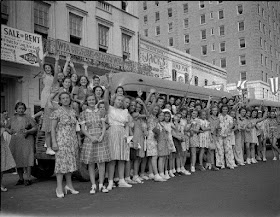 |
| A group of young girls from public playgrounds of New Orleans about to take off for Camp Bena Lea near Covington, August 19, 1941. This is part of the popular WPA Recreation Project (Children of the WPA). |
The Soviets scuttle river monitor Vidista at Kyiv to avoid capture.
Soviet submarine M-33 (Lt Surov) unsuccessfully attacks Romanian submarine Delfinul off Constanza, Romania.
Soviet submarine L-4 (Lt Cdr Polyakov) lays 20 mines off Cape Olinka, Romania.
Battle of the Pacific: German raider Komet has been operating off the Galapagos Islands recently. Today, it scores its third success in the area, sinking 9036-ton British freighter Devon about 200 miles southwest of the islands. The entire crew of Devon survives and board Komet as prisoners.
 |
| Reza Shah Pahlavi hands second son Ali Reza his commission as an officer at graduation exercises at Iran's "West Point" in Tehran, 19 August 1941 (AP). |
Partisans: The Germans execute Szmul Tyszelman and Henri Gautherot at the Vallée-aux-Loups in Châtenay-Malabry, Hauts-de-Seine. Tyszelman and Gautherot were among a group of about 100 demonstrators who staged a protest on 13 August 1941 at the Strasbourg – Saint-Denis metro station in Paris. The protest featured the group singing "La Marseillaise" and carrying the tricolor flag. This incident induced the German occupation authorities in France to ban the French Communist Party, and this, in turn, induces the communists to arm themselves and kill German soldiers. The entire situation escalates quickly, and by the end of August the Germans are executing numerous hostages and the resistance fighters are assassinating Germans.
US Military: The US Marine 1st Defense Battalion sets up a permanent military garrison on Wake Island with 449 recently arrived soldiers.
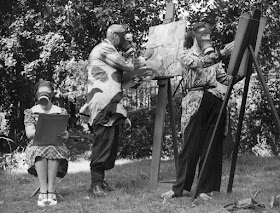 |
| British artist Albert Perry at work with some of his pupils during their daily one-hour gas mask practice, August 19, 1941. (Fox Photos/Getty Images). |
We talked about the Jewish problem. The Führer is convinced that his earlier prophecy in the Reichstag is proving correct, that if the Jews succeed again in provoking another world war it would end with the annihilation of the Jews. This is being proved in these weeks and months with an apparently eerie certainty. In the East, the Jews must pay for this.The Germans are still trying to figure out the most efficient way to exterminate large groups of people. At the moment, the usual method on the Eastern Front is to march people out of town to pits and shoot them. However, this is having a poor effect on German troop morale, so other methods are being tried.
Hitler later has dinner with his cronies and justifies his orders that can send thousands of men to their deaths:
If I am reproached with having sacrificed a hundred or two thousand men by reason of the war, I can answer that, thanks to what I have done, the German nation has gained, up to the present, more than two million five hundred thousand human beings. If l demand a tenth of this as a sacrifice, nevertheless I have given 90percent. I hope that in ten years there will be from ten to fifteen millions more of us Germans in the world. Whether they are men or women, it matters little: I am creating conditions favorable to growth.He predicts that Ukraine and the Volga region will become the "granaries of Europe," England, he implies, will wither away on the fringes of humanity because "It is not tolerable that the life of the peoples of the Continent should depend upon England." Naturally, the United States and the Americas do not even enter the equation because, in Hitler's worldview, they simply don't count.
At Kiselin, Ukraine, 48 Jews are executed on the outskirts of town with the assistance of Ukrainian police.
American Homefront: Pittsburgh Pirates manager Frankie Frisch goes on the field at Brooklyn's Ebbets Field during the second game of a doubleheader (the Pirates lost the first game) because he feels it is too rainy to continue. To make his point, he carries onto the field an umbrella and opens it upright in front of the three umpires. Everyone in the stadium bursts into laughter and Head Umpire Jocko Conlan immediately ejects Frisch from the game. As he heads back to the locker room, Frisch turns and says, "Can’t a guy have any fun anymore?" Norman Rockwell uses the incident years later as an inspiration for his famous cover, "Bottom of the Sixth."
August 1941
August 2, 1941: Uman Encirclement Closes
August 3, 1941: Bishop von Galen Denounces Euthanasia
August 4, 1941: Hitler at the Front
August 5, 1941: Soviets Surrender at Smolensk
August 6, 1941: U-Boats in the Arctic
August 7, 1941: Soviets Bomb Berlin
August 8, 1941: Uman Pocket Captured
August 9, 1941: Atlantic Conference at Placentia Bay
August 10, 1941: Soviet Bombers Mauled Over Berlin
August 11, 1941: Rita Hayworth in Life
August 12, 1941: Atlantic Charter Announced
August 13, 1941: The Soybean Car
August 14, 1941: The Anders Army Formed
August 15, 1941: Himmler at Minsk
August 16, 1941: Stalin's Order No. 270
August 17, 1941: Germans in Novgorod
August 18, 1941: Lili Marleen
August 19, 1941: Convoy OG-71 Destruction
August 20, 1941: Siege of Leningrad Begins
August 21, 1941: Stalin Enraged
August 22, 1941: Germans Take Cherkassy
August 23, 1941: Go to Kiev
August 24, 1941: Finns Surround Viipuri
August 25, 1941: Iran Invaded
August 26, 1941: The Bridge Over the Desna
August 27, 1941: Soviets Evacuate Tallinn
August 28, 1941: Evacuating Soviets Savaged
August 29, 1941: Finns take Viipuri
August 30, 1941: Operation Acid
August 31, 1941: Mannerheim Says No
2020
